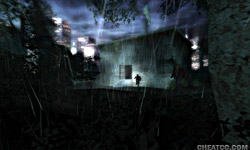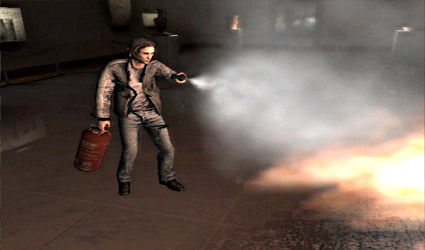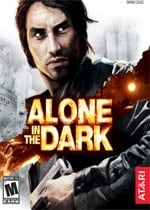Where Dying Is a Fact of Life
Alone in the Dark is a traditional horror/survival game. I use the word “traditional” because it sounds more polite than “same old song and dance,” which may better describe the gameplay. Alone in the Dark is a by-the-numbers horror/survival game that is not destined to leave its mark on the genre, even though the series was instrumental in creating it. Not only is there nothing innovative here, but it’s just not very much fun.

It tries so hard to impress with a convoluted storyline, but it just can’t hold things together. It’s filled with flaws in logic; situations are not explained properly, causing you to lose your sense of purpose. You are not in control, the game is. The storyline and gameplay is a Frankenstein creation of piecemeal elements stitched haphazardly together and brought to life to terrorize the gaming community. It’s a monstrosity all its own.
It must be really disappointing for the developers of the original Alone in the Dark to see other imitators such as Resident Evil and Silent Hill claim top honors in the genre, while Alone in the Dark remains essentially alone…in the dark. The series started life in the early 90s, and while it may not have defined the genre, it certainly inspired it. Unfortunately, the series just didn’t have the personality that games such as Resident Evil were able to convey. Everything from the story to the control system were improved on by these imitators, not to mention these games make you feel involved in the story rather than a person just playing a game, not to mention the uneasy feelings. Alone in the Dark brings you a few moments of shock, but these other games marinate you in the chills.

In keeping with tradition, the plot follows the adventures of a protagonist in the midst of a mysterious situation while suffering from amnesia. In this case, it’s Ed Carnby. Not only does he not know where he is and why, but he doesn’t even know who he is. He’s held captive by a group of mysterious men that seem to be in the midst of doing away with him. This plot device allows for a lot of revelations, which are uncovered throughout the game through various means. It’s supposed to maintain your interest, but unfortunately, the story is too heavy on details, making you lose interest quickly. So, let’s just get on with it and start killing things.
Zombies, bats, giant moths, spiders, and other monsters prowl the streets, sewers, alleys, and buildings of New York City. There is more to the gameplay than just a shooting gallery, and that’s both a blessing and curse. It’s a blessing because a diverse assortment of gameplay elements makes things more interesting, but it’s also a curse because they don’t blend well. Overall, the control mechanics are awkward, especially in the vehicle driving stages and while interacting with the environment, where the icons for these objects are not always visible, causing you to run around pressing the action button at everything on the screen like a crazed hamster in a cage. Doors, stairs, ledges, boxes, and other objects can be used to elevate your character to different heights, which can be used to avoid dangerous areas or simply to move on to the next stage. These are important paths that players should not have to miss simply because the icon identifying where to interact with it appears off-screen. Puzzle-solving is a important element in the horror/survival genre, but searching for access points is nothing more than trial and error, and that’s just not fun at all.

Different gameplay elements consist of exploring, combat, platforming, on-rails shooting, puzzle solving, collecting, and vehicle driving. Only a few of the elements are satisfying, while others are marred by a clumsy control system and/or mechanical flaws such as a weak collision detection system, which at times fails to register some of your actions. Thankfully, there are not too many driving sequences. They are primarily used to outrun dangers such as attacking monsters, firestorms, and earthquakes. The cars feel like boats on ice. Even at low speeds they can spin out of control, and that’s just from taking a turn too fast. Watch out if you actually hit something. Another problem with the driving stages is that you have to memorize the escape route by trial and error. Dying is a fact of life in this game.
You have to keep an eye on your health by checking your blood levels. It’s easy to forget to do since there isn’t a clear warning system. Health points can be pretty scarce in some stages, causing you to start from the last un-skippable cutscene. Melee weapons and running away are your best defense.

The guns are actually accurate and effective, but the supply of ammo is limited. You can take swipes at the monsters with various sticks and pipes, but there is some latency in the controls that cause the character to delay the command up to a second or two, and that can cost you some serious health if the creature gets to you first. Invisible walls are common, forcing you through a linear path like a rat in a science experiment. The control system is awkward and brings to mind the confusing and cumbersome system in the original Resident Evil for the Dreamcast. But when all else fails, you can always run away from your problems, literally or figuratively, by skipping to the next level. Nothing could make you feel less like a hero.
You are forced into either the first or third person perspective for specific tasks. When climbing or otherwise engaging objects in the environment, you will do so in the third-person perspective, while shooting is done in first-person. Other than that, you can choose from any perspective, and I wish I could tell you that one is better than the other. At times, the camera angle is too tight, making it difficult to follow your enemy in relation to the environment; you just don’t have enough room to move. I must admit that graphically the metropolis of New York is well represented. It’s huge in scope with plenty of skyscrapers lining the horizon.
Although suggested in the title, the game is dark; too dark! There are times when you are actually required to close your eyes so that you can detect clues that will help you with certain situations, but some of the environment is just too gray, making it hard to discern objects. You are going to have to increase the brightness on your TV screen. Too bad that night-vision goggles were not an option. Character models are decent, but generic. Facial expressions are static. The dialogue is predictably bad, but oddly enough, the voiceover work is exceptionally good despite the hack writing. Expect a lot of F-sharps thrown in for little reason. Framerate hiccups appear intermittently but don’t interfere with the gameplay. Musically, the score couldn’t be better; it’s atmospheric and fitting. You’re likely to get more chills from the soundtrack than the gameplay.
Alone in the Dark can be played in a day. You can actually skip levels if you get too frustrated, but you can save a lot of frustration by just skipping the game entirely.
RATING OUT OF 5 RATING DESCRIPTION 2.3 Graphics
Unnecessarily dark in sections. The characters have flat expressions. Good skyline though. 2.0 Control
Complicated and glitchy. Think original Resident Evil. 4.5 Music / Sound FX / Voice Acting
Exceptional soundtrack and voiceover work despite weak dialogue. 2.0 Play Value
Too many flaws and trial and error gameplay make this one no fun. 2.1 Overall Rating – Poor
Not an average. See Rating legend above for a final score breakdown.
Game Features:
